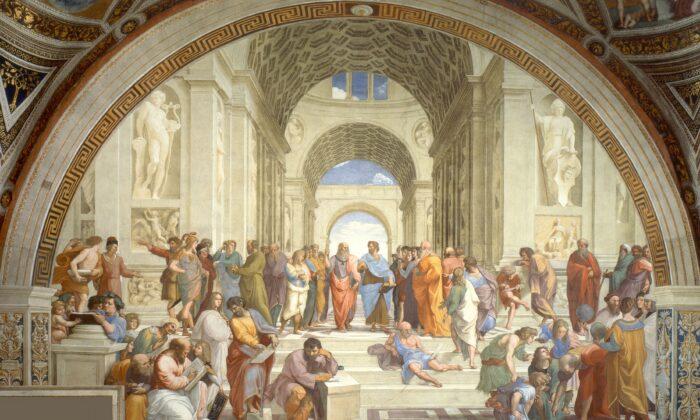According to the artist and art historian, Giorgio Vasari, the fresco depicts “the theologians reconciling philosophy and astrology with theology…” and Raphael “portrayed all the wise men of the world presenting different arguments” (Vasari 312).
The fresco depicts over fifty figures, but we will only look at the two central figures who represent Plato and Aristotle.

Raphael depicts Plato and Aristotle standing shoulder to shoulder. Plato is to the left and is thought to be modeled after Leonardo da Vinci, one of Raphael’s contemporaries. Plato holds his book “Timaeus” under his left arm and points up to the sky with his right hand. He wears red and grey which may represent the intangible elements of fire and air.
Aristotle, who was Plato’s student, is to the right of Plato. He carries his book “Nicomachean Ethics” in his left hand and points his right hand forward with his palm facing the ground. He wears blue and green which may represent the tangible elements of water and earth.
What does all of this mean for aesthetics, our understanding of beauty, and how we experience the world?

If we look at the top of the composition where Plato points, we see geometrical forms that hover over all of the figures below. We can interpret that these geometric forms represent the order and harmony of the universe’s structure.
Interestingly enough, Leonardo, the very artist that Raphael uses as a model for Plato, illustrated Platonic solids for Luca Pacioli’s book “The Divine Proportions” in 1509. These mathematical models were thought to correspond with the divine order of existence.

Depicted below the geometric forms, but still above the human figures, are two marble statues of the gods Apollo and Athena.
Apollo, on the left, is the god of beauty, mathematics, and order. He is depicted with a stringed instrument in his left hand, which would make its sound beautiful according to the length—that is, the measurement—of its strings. The traditional musical scale of the west is mathematically ordered.
Athena, on the right, is the goddess of strategy and wisdom. On her platform, she balances the aegis, a shield possessing the head of Medusa. Anyone who would look into the eyes of Medusa would turn to stone, becoming both hard and unfeeling; Plato’s philosophy requires the abandonment of emotion for the pursuit of absolute, stone cold Truth.
Thus, Plato suggests that true beauty lies with the divine craftsman. True beauty is guided by the mathematically logical forms of our intellect absent any emotion. Artists who merely imitate nature are liars because they are unable to communicate these Truths that exist beyond mere appearances.
As liars, these artists risk leading people away from Truth with their works of art, and artists should be censored for this reason.

Aristotle points his hand out toward the scene in front of us. Some of the greatest thinkers in known history are talking about, sharing, and debating ideas and experiences. Many are separated into small groups in which they work toward a common goal. Others work or think in isolation.
Just as the area above the figures represents aspects of Plato’s philosophy, the figures below represent Aristotle’s ethics. Aristotle’s ethics concerned examining the causes and effects within nature to determine what actually worked to make life better.
In other words, we don’t have to go beyond nature to find Truth, because there are truths right here and right now that we must come to understand. One of those truths deals with our relationship with the world around us. For instance, we can often determine what is ethical action based on whether the effect of the said action produces a natural pleasure within us.
We imitate when we learn, and knowledge produces this experience of pleasure. We also gain pleasure from seeing something successfully imitated. Raphael’s ability to imitate the appearance of human beings in “School of Athens” gives us a certain sense of pleasure.
Thus, in contrast to Plato, Aristotle believes there is a place for imitation because imitation can produce pleasure within us, and therefore it must be ethical. One of these pleasurable experiences can occur by way of the work of art, and Aristotle calls it catharsis.
Catharsis is the experience in which we are overwhelmed with the emotions of pity and fear in such a way that they purify us. It’s like seeing a good movie in which we both fear for the safety and pity the plight of the protagonist. In a way, this emotional response—a type of compassion—gives us an experience that purifies us as human beings, and we become better because of it.
Thus, the arts can provide us with the emotional education on how to best live amongst our fellow human beings; it can show us how to think about, share, and debate our ideas and experiences as human beings in an ethical way. In other words, art can emotionally connect us with each others’ lived experiences. We can see this in Raphael’s fresco: he has placed people from different locations and time periods in the same painting, sharing their ideas and experiences with each other and with us, five hundred years into the future.
What do you think? Does Plato have a point: are the arts dangerous in what they represent, and should they be censored to only relay the intellectual and emotionless intentions of the divine craftsman? Or is Aristotle right: the arts educate us in our emotions and connect us with the human experience?
Or maybe these two aesthetic arguments do not contradict each other as much as we may initially think?





